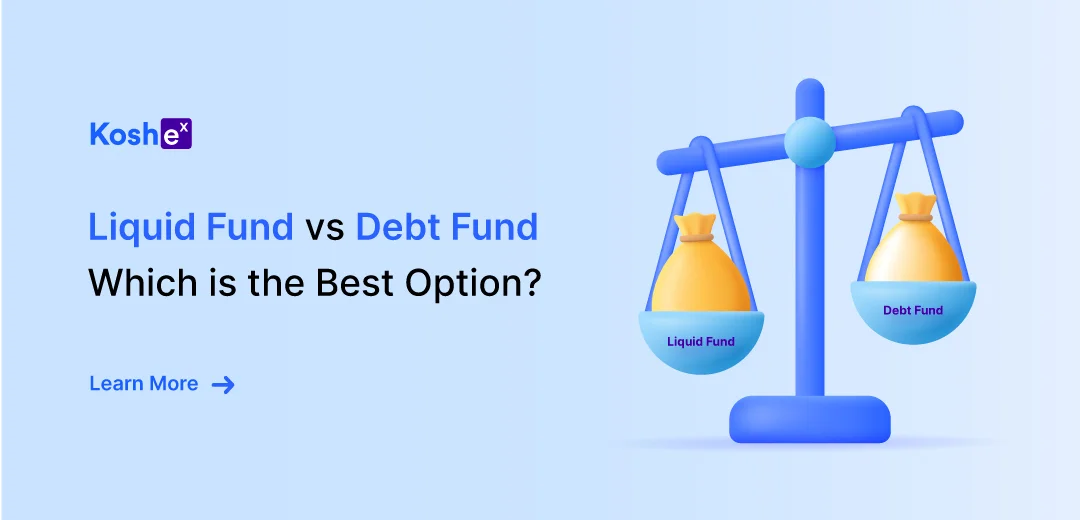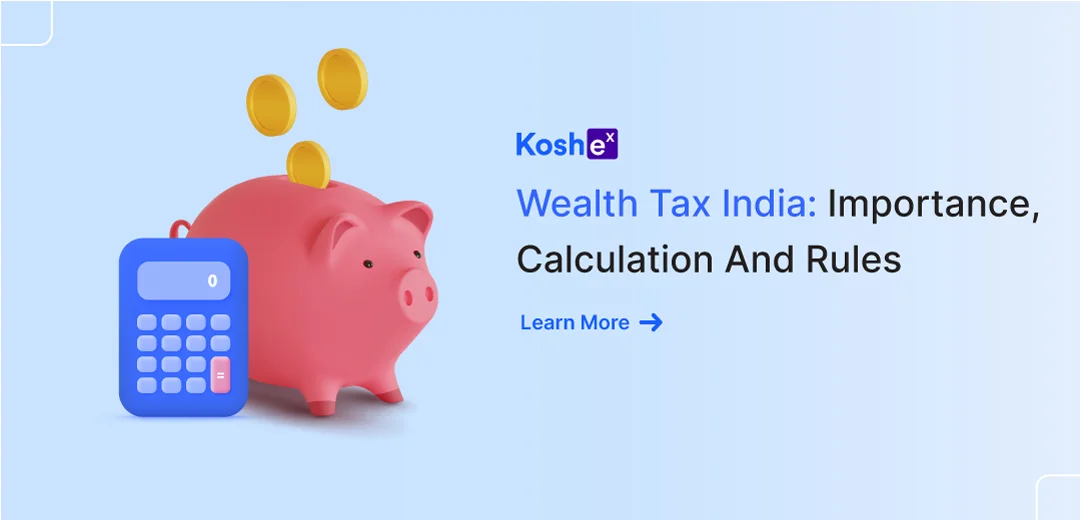Investing in mutual funds through a Systematic Investment Plan (SIP) is very popular nowadays. As per AMFI data, there are 61.2 million SIP accounts in India, and in the first 9 months of FY23, the SIP contribution to different funds stood at Rs.1,14,154 cr.
Investing in equity mutual funds through the SIP route is currently prevalent due to the flexibility it offers to investors. At this point, if a question has cropped up in your mind about whether you should start a SIP in a debt fund, the answer is yes. You can replace your traditional monthly investment scheme, like Recurring Deposit (RD), with a SIP in a debt fund.
Now investing in mutual funds is easier than ever before. Using Koshex, you can invest in a plethora of mutual fund schemes from 40 fund houses. Moreover, through this platform, you can invest through SIP or lumpsum in these funds.
Debt Funds
Debt funds pool money from investors and park it in various fixed-income avenues such as bonds, money market instruments, etc. Debt funds are apt for risk-averse investors looking for regular income. Debt funds are less risky than their equity counterparts.
At the same time, they provide better returns and are more tax-efficient than traditional investment options, such as recurring and fixed deposits.
Systematic Investment Plan (SIP)
Investing a fixed amount in regular intervals, preferably every month, in mutual fund schemes is called SIP. Through SIP, you can start your mutual fund investing with as low as Rs. 500. Further, SIP is a better strategy to accumulate and grow your wealth over the long term.
Due to its immense benefits, SIP is gaining popularity among Indian mutual fund investors. The rupee cost averaging is the primary advantage of SIP.
Rupee cost averaging
The rupee cost averaging is based on the classic principle of buying more when the market goes down and less when the market moves up.
Thus, you can lower the average buying cost per unit in the long run. Rupee cost averaging helps you invest better in a volatile market. In an upswing, it restricts you from buying more units at a higher price.
For instance, you invest Rs.2,000 monthly in a mutual fund scheme via SIP. In January, this fund’s Net Asset Value (NAV) stood at Rs.40. So, you’ll get 50 units of the fund. Suppose in February, the market went up, and the NAV of this fund reached Rs.45. Then you get 44.44 units of the fund.
Imagine in March, the market has undergone a correction, and the NAV of the fund came down to Rs.38. Now, you’ll get 52.63 units of the fund. In just 3 months, you’re receiving 147.07 units at an average cost of Rs.40.79 per unit (6,000/147.07).
Should you start a SIP in a debt fund?
A large chunk of the investing community still believes that only lump sum investing is possible in debt funds. But in reality, you can do SIP in debt funds as well.
At this point, you may think that the primary aim of SIP investments is to beat market volatility; but debt funds are low-risk investment options. Then, how does SIP work well in debt funds?
Debt funds are indeed less volatile compared to equity funds. But that doesn’t mean that volatility is zero in debt funds. The price of fixed-income instruments also moves up or down with changes in the interest rate and credit spreads.
You can see high price volatility in debt funds that have a long duration as a result of the change in bond yield.
In brief, only some debt funds are suitable for SIP. Hence, SIP is not ideal for debt funds categories like overnight, liquid, money-market, and savings funds.
However, it works well in short-duration, long-duration, corporate bonds, and banking and PSU funds.
You can start a SIP in a long-duration fund if your investment goals are more than 12 months away. Similarly, if you have a too-long investment perspective, create a SIP in a dynamic or long-duration fund.
How do debt funds function in a falling market?
Debt funds demonstrate lesser fluctuations during market volatility than their equity-based counterparts because they park their assets in bonds and debt securities that provide stable returns.
Debt instruments and debt securities allow their issuers to raise capital from multiple lenders. In return, they pay them fixed interest regularly until maturity. On maturity, they repay the capital to the lenders per the contract’s terms and conditions.
In brief, debt funds buy debt instruments/securities with investors’ money and earn interest on that money. The returns the debt fund investors receive depend upon these earnings and not on the ups and downs of the share market. Thus, debt funds help maintain your portfolio’s stability even in a falling market.
Advantages of SIP in debt funds over traditional monthly investment schemes
The most important advantages of SIP in debt funds over monthly investment schemes like RD are:
· You’ll have a wide range of options in debt funds; hence, you can select one that matches your investment goal. This does not apply to traditional schemes.
· Debt funds are highly liquid. You can redeem any number of units according to your financial needs while continuing your SIP investment.
While in a traditional scheme, in case of an emergency financial need, you must close your account and withdraw money. Further, premature withdrawals attract a penalty.
· Traditional schemes offer fixed returns, and often their returns fail to beat inflation. Though your SIP in debt funds does not guarantee any returns, historically, they provided better returns than traditional schemes. Returns from debt funds depend upon the condition of the debt market.
· Flexibility in installments is another advantage of SIP in debt funds over conventional schemes. In SIP, you can decide the installment payment period according to your convenience, such as monthly, quarterly, etc. Usually, only a monthly installment option is available with traditional avenues.
· Last, tax efficiency is the most important advantage of SIP in debt funds over conventional investment options. Profits on your investments in debt funds will be taxed only when you redeem its units.
Depending upon your holding period, it’ll be taxed as short-term or long-term capital gains with indexation benefits. However, indexation benefits are not applicable in traditional avenues. And usually, returns from them will be taxed as per your income tax slab.
Conclusion
Through SIP in debt funds, you can accumulate money for your long-term investment goals. Debt funds are less exposed to market risk and, at the same time, provide better returns than conventional investment options.
Further, they are more tax-efficient and liquid than traditional options. Start a SIP today to maximize your returns from debt funds.
Koshex is an AMFI-registered platform that helps you to invest in mutual funds, fixed deposits, and digital gold. You can start your SIP in debt funds through Koshex in just 3 clicks. Depending on your financial goals, Koshex provides you with personalized investment suggestions as well.
FAQs
1. How do I select the right debt fund for me?
You should check the following 4 points while selecting a debt fund.
1. Check the average maturity of its portfolio. The longer the maturity period, the higher the return will be.
2. If a large chunk of the portfolio consists of corporate bonds, ignore the fund as it can face redemption pressure at any time which will impact its NAV.
3. Check the fund’s assets. Ignore the fund if it manages only a small corpus.
4. Check the modified duration of the fund. It implies how sensitive the fund is to interest rate fluctuations. Funds with a longer modified duration will see a significant change in their NAV with a movement in interest rate.
2. Which debt funds are suitable if my goal is just a few months away?
Investing in liquid or money-market funds will be suitable for short-term goals as they have negligible volatility due to the non-existence of equities in their portfolio.









Leave a Comment